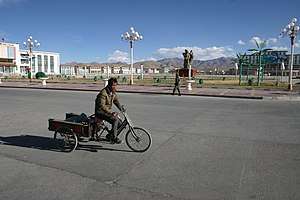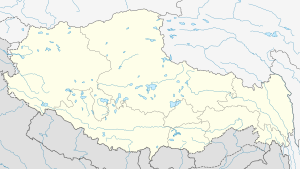Shiquanhe
Shiquanhe (Chinese: 狮泉河镇; lit.: 'Lion Spring River Town'), traditionally known as Sênggêkanbab or Sênggêzangbo (Tibetan: སེང་གེ་ཁ་འབབ་ ), is the main town and administrative seat of Ngari Prefecture,[1] Tibet Autonomous Region, China. Shiquanhe is located on the confluence of Sênggê Zangbo (Indus River) and Gar River.
Shiquanhe 狮泉河镇 · ནག་ཆུ་གྲོང་རྡལ། | |
|---|---|
Town | |
| Sênggêzangbo | |
 The main square in Shiquanhe | |
 Shiquanhe | |
| Coordinates (Shiquanhe town government): 32°29′35″N 80°06′06″E | |
| Country | People's Republic of China |
| Region | Tibet Autonomous Region |
| Prefecture | Ngari |
| County | Gar |
| Elevation | 4,255 m (13,960 ft) |
| Time zone | UTC+8 (CST) |
| Postal code | 859000 |
| Shiquanhe | |||||||
|---|---|---|---|---|---|---|---|
| Chinese name | |||||||
| Simplified Chinese | 狮泉河 | ||||||
| Traditional Chinese | 獅泉河 | ||||||
| |||||||
| Tibetan name | |||||||
| Tibetan | སེང་གེ་ཁ་འབབ། | ||||||
| |||||||
Name
Historically the town was also known as Ger.[2] This name, in the form "Gar" (simplified Chinese: 噶尔; traditional Chinese: 噶爾; pinyin: Ga'er), is now used to refer to the entire county. As is the custom with Chinese county seats, Gar is also often used to refer to the county seat as well, and it may be labeled that way on maps.[3]
Being the main town of Ngari Prefecture (which is known in Chinese under the Sinicized form of its name, Ali Prefecture), the town is also commonly known in English as Ngari or Ali (Chinese: 阿里; pinyin: Ālǐ) Town; this is what many guidebooks use as the primary name for the town.[4] In Tibetan, Ngari is only the name for the prefecture, and not the town.
The name Shiquanhe is originally the name of the river; in Tibetan, it is Sengge Zangbo (in SASM/GNC/SRC transcriptions, sometimes simply Senge Zangbo),[1] Senge Zangbu (森格藏布) or Sengghe Tsangpo (in a transcription used in Western books).[4] The source of that river, a hot spring supposedly resembles a lion's mouth; hence the name, interpreted as "river flowing from lion's mouth".[1][4]
History
When the Ngari Prefecture of the PRC was established in 1959, its capital was at the place named Kunsa, whose seat is Gar Chongsar (སྒར་གྲོང་གསར), located elsewhere in Gar County. It was moved from there to Shiquanhe in 1965, due to the extremely difficult living conditions in Kunsa the current location of Ngari Gunsa Airport.[1] At that time, Shiquanhe's population was merely 400.[1]
The modern Chinese-style town is situated at the confluence of the Sengge River and Gar River.[5] According to a government-affiliated source, the population of Shiquanhe had grown from just over 1,500 to over 20,000 in 30 years (1978–2008), and people there now "enjoy their life because the city has been equipped with culture and commerce facilities".[6] Western guidebook writers have referred to the place as a "concrete monstrosity of a town".[4]
The place has several primary schools and a secondary school.[1]
Sênggêkanbab has two banks, but only the Agricultural Bank of China, near the army post west of the roundabout, will change foreign currency. There is also a main post office near the roundabout.
Transportation
Ngari Gunsa Airport, near the town of Shiquanhe, started operations on 1 July 2010, becoming the fourth civil airport in Tibet.[7]
Air China's southwestern branch will operate flight services from Chengdu to Lhasa and on to Ngari – a total of 2,300 km (1,400 mi) – every Tuesday and Friday. "The flight leaves Chengdu at 5:50 AM and arrives at Lhasa two hours later," Bao Lida, a company press official was quoted as saying. "It leaves Lhasa at 8:40 AM and arrives at Ngari at 10:20 AM." the 1,098 km (682 mi) Lhasa-Ngari flight service would start from 2,590 yuan (About US $400). The report said Air China expects to transport 50-60 passengers in winter and 20-30 passengers in summer during each flight service.[8]
Climate
Shiquanhe has a cold desert climate (Köppen climate classification: BWk) with short, very mild summers and very cold, dry winters.
| Climate data for Shiquanhe (1981–2010 normals) | |||||||||||||
|---|---|---|---|---|---|---|---|---|---|---|---|---|---|
| Month | Jan | Feb | Mar | Apr | May | Jun | Jul | Aug | Sep | Oct | Nov | Dec | Year |
| Record high °C (°F) | 6.4 (43.5) |
9.5 (49.1) |
13.4 (56.1) |
15.7 (60.3) |
20.5 (68.9) |
25.2 (77.4) |
32.1 (89.8) |
26.4 (79.5) |
23.7 (74.7) |
16.7 (62.1) |
12.7 (54.9) |
7.1 (44.8) |
32.1 (89.8) |
| Average high °C (°F) | −4.1 (24.6) |
−2.0 (28.4) |
2.3 (36.1) |
7.4 (45.3) |
12.6 (54.7) |
18.1 (64.6) |
21.5 (70.7) |
20.5 (68.9) |
16.3 (61.3) |
8.2 (46.8) |
2.9 (37.2) |
−1.6 (29.1) |
8.5 (47.3) |
| Daily mean °C (°F) | −12.0 (10.4) |
−9.2 (15.4) |
−4.8 (23.4) |
0.1 (32.2) |
5.1 (41.2) |
10.7 (51.3) |
14.4 (57.9) |
13.8 (56.8) |
9.3 (48.7) |
0.5 (32.9) |
−5.7 (21.7) |
−10.1 (13.8) |
1.0 (33.8) |
| Average low °C (°F) | −19.7 (−3.5) |
−16.9 (1.6) |
−12.6 (9.3) |
−7.9 (17.8) |
−2.7 (27.1) |
3.1 (37.6) |
7.7 (45.9) |
7.5 (45.5) |
2.0 (35.6) |
−8.0 (17.6) |
−14.8 (5.4) |
−18.2 (−0.8) |
−6.7 (19.9) |
| Record low °C (°F) | −36.6 (−33.9) |
−30.2 (−22.4) |
−25.3 (−13.5) |
−17.9 (−0.2) |
−11.2 (11.8) |
−6.6 (20.1) |
−0.6 (30.9) |
−0.4 (31.3) |
−10.0 (14.0) |
−17.0 (1.4) |
−23.5 (−10.3) |
−32.9 (−27.2) |
−36.6 (−33.9) |
| Average precipitation mm (inches) | 1.6 (0.06) |
1.2 (0.05) |
1.4 (0.06) |
1.3 (0.05) |
2.9 (0.11) |
3.7 (0.15) |
21.4 (0.84) |
23.8 (0.94) |
5.7 (0.22) |
2.0 (0.08) |
0.3 (0.01) |
1.1 (0.04) |
66.4 (2.61) |
| Average relative humidity (%) | 36 | 33 | 31 | 29 | 30 | 31 | 39 | 43 | 36 | 27 | 24 | 31 | 33 |
| Source: China Meteorological Administration[9] | |||||||||||||
Shiquanhe Observatory
China, Japan, and South Korea are currently entertaining plans to construct a large high-altitude observatory on a ridge 25 km (16 mi) south of Shiquanhe, which was selected after a series of site surveys through Tibet and western China for candidate sites. Atmospheric conditions from the site's elevation 5,050 m (16,570 ft) above sea level have been roughly characterized, initial facilities (including two small domes) have been built, and a 25 cm pathfinder telescope project is in place as of 2012, with 50 and 60 cm telescopes planned for 2013 and 2014 and a 3 m telescope in the indefinite future: but the ambitions for the site include the possibilities of megaprojects like a 30 m-class competitor to E-ELT and a 10–20 m class spectrometer as a sequel to LAMOST.[10][11]
Also planned for the site[12] is the Ali CMB Polarization Telescope (AliCPT) for studying the polarization of the cosmic microwave background.[13] This location is, during winter, as high and dry (and thus good for observations as) the South Pole location of the similar BICEP and Keck Array telescopes,[12] with the tremendous logistical advantage of being 30 minutes' drive from the airport and city.[13]:7
Construction has begun on the telescope, codenamed Ngari No.1, and it is expected to enter operations in 2021.[14]
Footnotes
- Ngari, China's Tibet (in French), China Intercontinental Press, 2001, pp. 14–18, ISBN 7-80113-835-X (This book uses SASM/GNC/SRC transcriptions)
- Archived November 12, 2008, at the Wayback Machine
- E.g. 使用中国地图集 [Practical Atlas of China]. 2008. pp. 142–143. ISBN 978-7-5031-4772-2.
- Buckley, Michael (2006), Tibet, Bradt Travel Guide (2 ed.), Bradt Travel Guides, pp. 222–223, ISBN 1-84162-164-1
- Dorje (1999), p. 1151.
- Archived July 21, 2011, at the Wayback Machine
- "Tibet's fourth civil airport opens". News.xinhuanet.com. Archived from the original on 14 December 2010. Retrieved 17 February 2015.
- Archived July 9, 2010, at the Wayback Machine
- 中国气象数据网 - WeatherBk Data (in Chinese). China Meteorological Administration. Retrieved 2020-04-16.
- "China invites Japan and South Korea to build observatory in disputed Shiquanhe (Aksai Chin)". Retrieved 17 February 2015.
- Stone, Richard (7 September 2012). "World-Class Observatory Rising on 'Roof of the World'". Science. Sciencemag.org. 337 (6099): 1156–1157. Bibcode:2012Sci...337.1156S. doi:10.1126/science.337.6099.1156. PMID 22955808.
- Yifang, Wang. The Quest of Infinity. CityU Distinguished Lecture Series. City University of Hong Kong. 42 minutes in.
- Li, Yong-Ping; Liu, Yang; Li, Si-Yu; Li, Hong; Zhang, Xinmin (27 November 2017). "Tibet's Ali: A New Window to Detect the CMB Polarization". arXiv:1709.09053 [astro-ph.IM].
- Xinhua News Agency (January 7, 2017). "China to set up gravitational wave telescopes in Tibet". China Daily. Archived from the original on January 12, 2017.
Construction has started for the first telescope, code-named Ngari No.1, 30 km south of Shiquanhe Town in Ngari Prefecture, said Yao Yongqiang, chief researcher with the National Astronomical Observatories of the Chinese Academy of Sciences. The telescope, located 5,250 meters above sea level, will detect and gather precise data on primordial gravitational waves in the Northern Hemisphere. It is expected to be operational by 2021.
References
- Dorje, Gyurme. (1999). Footprint Tibet Handbook with Bhutan. (2nd Ed.) Footprint Handbooks, Bath, England. ISBN 0-8442-2190-2.
